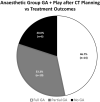An evaluation of the use and efficacy of behavioural therapy when treating paediatric patients with radiation therapy
- PMID: 37448103
- PMCID: PMC10715350
- DOI: 10.1002/jmrs.705
An evaluation of the use and efficacy of behavioural therapy when treating paediatric patients with radiation therapy
Abstract
Introduction: The paediatric radiation therapy group (PRTG) provided a multidisciplinary network to support patients accessing radiation therapy (RT). This study aims to evaluate the use and efficacy of behaviour therapy practices used by the PRTG.
Methods: A retrospective cross-sectional review of general anaesthetic (GA) utilisation for paediatric patients was completed between 1 January 2010 and 30 June 2014. The PRTG incorporated behavioural therapy techniques into all appointments but offered additional play appointments to children unable to comply with the requirements of RT. This aimed to increase their compliance and minimise GA use.
Results: Two-hundred and seventy-four patients had 5402 occasions of service, of which 1361 were delivered under GA (25.2%). Two-hundred and fifty-seven patients met the eligibility criteria. Patients under 8 years who required GA for their entire treatment reduced for each year of increase in age (odds ratio 0.37, 95% confidence interval 0.27-0.51, P < 0.001). Participants 3 years and younger were shown not as likely to change their GA requirements with the use of play appointments. Seventy-eight per cent (83/106) of 3-8-year-olds used no GA or ceased GA during treatment.
Conclusions: Most paediatric patients <3 years will gain minimal benefit to reduce GA use from additional play appointments. Children older than nine were not likely to require play appointments to be compliant with RT. Encouragingly, 53.3% of 3-8-year-olds who were categorised as full GA after CT planning did not continue to a full course of GA due to the behavioural therapy interventions of the PRTG.
Keywords: anaesthetic; paediatric; play; radiotherapy; therapy.
© 2023 The Authors. Journal of Medical Radiation Sciences published by John Wiley & Sons Australia, Ltd on behalf of Australian Society of Medical Imaging and Radiation Therapy and New Zealand Institute of Medical Radiation Technology.
Conflict of interest statement
The authors declare no conflict of interest.
Figures




Similar articles
-
Behavioural modification interventions for medically unexplained symptoms in primary care: systematic reviews and economic evaluation.Health Technol Assess. 2020 Sep;24(46):1-490. doi: 10.3310/hta24460. Health Technol Assess. 2020. PMID: 32975190 Free PMC article.
-
Pediatric radiotherapy preparation: a scoping review.Chin Clin Oncol. 2025 Feb;14(1):10. doi: 10.21037/cco-24-95. Chin Clin Oncol. 2025. PMID: 40081389
-
Use of general anaesthesia in paediatric dentistry: barriers to discriminate between true and false cases.Eur Arch Paediatr Dent. 2016 Apr;17(2):89-95. doi: 10.1007/s40368-015-0211-y. Epub 2015 Nov 21. Eur Arch Paediatr Dent. 2016. PMID: 26590995
-
Structured, intensive education maximising engagement, motivation and long-term change for children and young people with diabetes: a cluster randomised controlled trial with integral process and economic evaluation - the CASCADE study.Health Technol Assess. 2014 Mar;18(20):1-202. doi: 10.3310/hta18200. Health Technol Assess. 2014. PMID: 24690402 Free PMC article. Clinical Trial.
-
Automated Text Message Reminders Improve Radiation Therapy Compliance.Int J Radiat Oncol Biol Phys. 2019 Apr 1;103(5):1045-1052. doi: 10.1016/j.ijrobp.2018.11.050. Epub 2018 Nov 30. Int J Radiat Oncol Biol Phys. 2019. PMID: 30508618
Cited by
-
Supporting paediatric patients to receive radiation therapy without sedation or general anaesthetic.J Med Radiat Sci. 2023 Dec;70(4):357-359. doi: 10.1002/jmrs.734. Epub 2023 Oct 25. J Med Radiat Sci. 2023. PMID: 37880876 Free PMC article.
-
Evaluation of the positional reproducibility of sedation versus non-sedation state in pediatric radiotherapy: a retrospective study.Front Oncol. 2024 Oct 29;14:1475060. doi: 10.3389/fonc.2024.1475060. eCollection 2024. Front Oncol. 2024. PMID: 39534100 Free PMC article.
References
-
- Zhu Y, Stovall J Jr, Butler L, et al. Comparison of two immobilization techniques using portal film and digitally reconstructed radiographs for pediatric patients with brain tumors. Int J Radiat Oncol Biol Phys 2000; 48: 1233–1240. - PubMed
-
- Slifer KJ, Bucholtz JD, Cataldo MD. Behavioral training of motion control in young children undergoing radiation treatment without sedation. J Pediatr Oncol Nurs 1994; 11: 55–63. - PubMed
-
- Bucholtz JD. Issues concerning the sedation of children for radiation therapy. Oncol Nurs Forum 1992; 19: 649–655. - PubMed
-
- Pimm P, Fitzgerald E, Taylor L. Caring for children undergoing radiotherapy. Radiography 1997; 3: 27–30.
-
- Jay S, Ozolins M, Elliott CH, Caldwell S. Assessment of children's distress during painful medical procedures. J Health Psychol 1983; 2: 133–147.
MeSH terms
LinkOut - more resources
Full Text Sources
Miscellaneous

